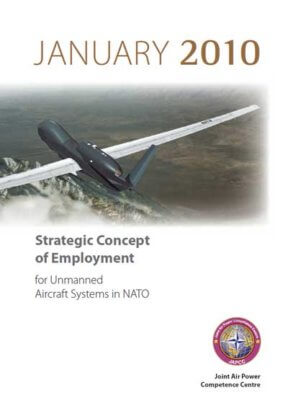Aim
This publication provides the fundamental guidance and an overarching concept for NATO operations and employment of unmanned aircraft systems (UAS) through the full spectrum of military operations.
Purpose
It describes a capabilities-based approach to UAS employment, which enhances the joint and coalition operator’s ability to execute assigned missions and tasks. This document recommends NATO guidance, considerations, and concepts for optimum UAS employment across the full spectrum of military operations. It is intended for use by NATO nations and coalition forces in preparing their operational and program plans, in support of service, joint, and coalition doctrine, and assist in CONOPS development. This publication does not restrict the authority of the Joint Force Commander (JFC) from organising forces and executing the mission in the most appropriate manner.
Application
The fundamental principles, guidance, and capabilities presented in this publication support the Ministries of Defence, the commanders of combatant commands, joint task forces, and subordinate components of these commands. While this document is not authoritative in nature, the recommended guidance offered should be followed except when, in the judgment of the commander, circumstances dictate otherwise. If conflicts arise between the contents of this publication and the contents of joint and doctrinal service publications, the joint publications will take precedence for the activities of joint forces.
Acknowledgements
The JAPCC would like to express its appreciation for the outstanding contribution by the United States Joint UAS Centre of Excellence. Their expertise and inputs were essential to the completion of this document. The authors also very much appreciated the exceptional contribution and critiques of the entire Joint UAV Panel community representing all NATO nations and NATO institutions involved in UAS operations.
Overview
This publication provides the NATO vision for the operation, integration, and interoperability of UAS until 2025. This document describes a capabilities-based approach to UAS employment, which enhances the joint operator’s ability to execute assigned missions and tasks. It emphasizes joint guidance for optimum UAS employment across a range of military operations. The document focuses at the operational (campaign) level of warfare and Civil Support (CS) for use by NATO and its multi-national/ coalition partners. Additionally, this document assists with the development of joint/coalition, Service doctrine, CONOPS, and operational plans.
Chapter I – Introduction: Sets the stage for a UAS capability discussion by briefly describing the background and the necessity for tasking which resulted in this document development. This chapter also briefly describes and differentiates UAS from manned aircraft.
Chapter II – UAS Family of Systems: Defines and describes key UAS terms and related employment concepts. It begins with a discussion of UA S components (aircraft, payload, communications, control, support, and the human aspect). Next it defines NATO UAS categories. Finally, it provides an overview of UAS capabilities and limitations by category.
Chapter III – Planning and Employment Considerations: Highlights the most important issues regarding UAS employment in the near term. Optimal UAS employment presents complex and unique challenges requiring joint planners to be educated with the information needed to mitigate those challenges.
Chapter IV – UAS Support to Joint or Coalition Force Operations: Provides a top-level discussion for the optimised employment of UAS based on current doctrine and near- to mid-term concepts. This chapter also highlights the range of potential operational missions in which UAS can be employed in support of the joint force or its component commanders.
Chapter V – Doctrine, Organisation, Training, Materiel, Leadership and Education, Personnel, Facilities, and Interoperability (DOTMLPFI) Considerations: Highlights UAS issues that may require DOTMLPFI changes or new materiel solutions. The chapter provides issues, discussions, recommendations, and ongoing efforts that are addressing the issues.
Appendix A – Operational Vignettes: Puts the discussion of Chapter IV into context by including vignettes to illustrate how UAS are employed in support of joint/coalition operations. The vignettes include a major operation and campaign, a non-combatant evacuation operation (NEO), urban, Homeland Defence (HD), and Civil Support operations.











